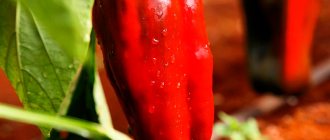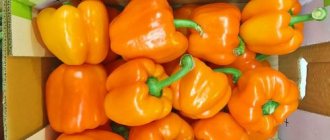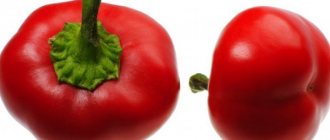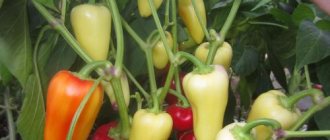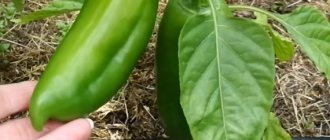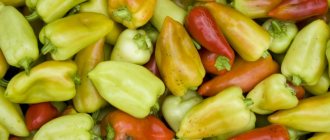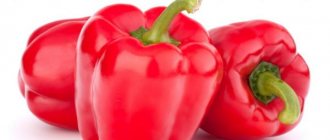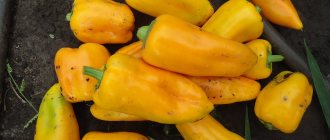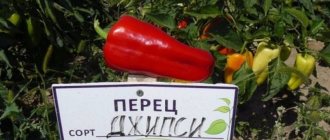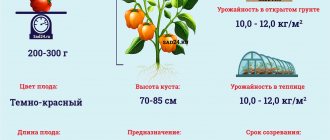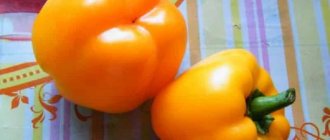Vegetable growing » Pepper
0
1171
Article rating
Kira Stoletova
Husky pepper f1 is an early-ripening, highly productive hybrid of bell pepper with a classic cone shape. Due to its high yield and resistance to bad weather conditions, this pepper variety is popular among gardeners.
Salad pepper variety Husky f1
Characteristics of the variety
Husky sweet pepper guarantees an early harvest and bears fruit with a very high yield.
It is thanks to this that the hybrid is the best choice for gardeners for growing both in film tunnels or greenhouses, and in open ground conditions. Pepper ripens within 55-60 days after planting the seedlings in the ground. When applying fertilizers, as well as in the presence of drip irrigation, the yield reaches 90-100 t/ha.
Description of the bush
An important advantage of the variety is its powerful root system, thanks to which Husky adapts well to stress and also tolerates temperature changes well. The design of the bushes is characterized by the presence of a large number of leaves that protect the fruits from direct sunlight and burns.
Description of the fruit
Husky pepper f1 is distinguished by its density, fruit quality and early ripening of the crop. The variety performs well during transportation.
The fruits of the Husky variety have an average size - from 6 to 12 cm, wall thickness - from 6 to 9 mm, cone-shaped; weight - 160-220 g.
When technically ripe, the fruits have a rich white or ivory color; when biologically ripe, they acquire a rich red tint with a pleasant shine.
Throughout the growing season, the fruits maintain a smooth surface and density. The yield of the variety is up to 10 kg per 1 sq. m landing.
General form
Husky pepper F1 is distinguished by accelerated fruit ripening and special endurance. The prototype of the name was one of the fastest sled dog breeds used by humans in the Far North.
The pepper looks like this:
- Branched bush up to 70 cm tall.
- The root system is powerful.
- There are many leaves on the stems. The surface of large plates is covered with wrinkles.
- The fruits are cone-shaped without expansions or contractions. The skin is glossy.
- Technically mature units are milky white in color (pictured). Biologically ripened red pepper.
- The walls of the fruit are quite thick. Sectional width 6-9 mm. The taste and aroma are characteristic of the culture, rich.
| Type of growth, bush height | Bushy, up to 70 cm |
| Ripe fruit color | Red |
| Planting scheme | 70x50 cm |
| Weight, length and shape of the fruit | 160-210 g, up to 14 cm, cone-shaped |
| Ripening period, yield | Early (100-110 days), 9-10 kg/m2 |
| Drop off point | exhaust gas/greenhouse |
| Diseases | Resistant to bacterial spot, tobacco mosaic virus, tolerant to powdery mildew and ascochyta blight |
| By type of use | Universal |
| Flowering type | Female |
Pests and diseases
Diseases and pests cause significant damage to the crop, sometimes even leading to its complete loss.
The Husky f1 hybrid is resistant to diseases such as bacterial black spot, and also has excellent resistance to the tobacco mosaic virus, but is still vulnerable to pests such as:
- aphid;
- Colorado beetle;
- slugs;
- whitefly;
- spider mite
In the fight against aphids and spider mites, the affected areas of the plant are sprayed with a decoction of tansy or wormwood, as well as an infusion of yarrow. To get rid of the Colorado potato beetle, the bushes are sprayed with infusion of celandine. To prevent slugs from appearing on peppers, small parsley bushes are planted nearby between the rows: its tart aroma repels slugs.
A particularly dangerous pest is the whitefly. If the pest is detected in time, it can be washed off with enough clean water. If the plant is already affected, it is treated with Inta-Vir by spraying the bushes. Dosage - 1 tablet per 9-10 liters of clean water.
Ripening time
Bell pepper is a fairly heat-loving crop, and therefore it is better to plant early fruits in the southern regions or in greenhouses that can provide the pepper with the necessary temperature conditions. The necessary climate in the air and soil is an important component of rapid growth and a large, tasty harvest.
If you live in a temperate climate zone, focus on mid-ripening varieties; in Siberia and northern regions - on late-ripening varieties. In order to understand what the growing season is for a particular variety, let’s orient them according to their ripening periods:
- Early ripening hybrids and varieties - up to 100 days from the appearance of the first seedlings, regardless of the conditions in which it was grown and when it was transferred to open ground;
- Mid-season - from 105 to 125 days;
- Late ripening - from 130 days and above.
When sowing seeds, be sure to rely on the calendar, namely, when you will transfer the seedlings to a permanent place of growth. If a seedling is kept in an apartment or greenhouse, it may lose time adapting to new conditions, and the growing season will shift significantly. The plant that is transferred already with flowers must be pinched and cropped.
When choosing a variety or hybrid, pay attention to the size and shape of the fruit. Choose pepper so that it best suits the parameters of where it will be used. . Do not forget that fruits turn a rich red color only during the period of biological ripeness; at technical ripeness, they are usually green or yellow.
Do not forget that fruits turn a rich red color only during the period of biological ripeness; at technical ripeness, they are usually green or yellow.
Husky pepper F1 sweet pepper seeds (Enza Zaden)
- Husky pepper F1 is a very early hybrid of sweet peppers from the Enza Zaden company.
- High yield.
- The growing season is 55 days from planting the seedlings.
- The plant is compact, powerful, strong root system.
- The fruits measure 6x12 cm, wall thickness is from 6 to 9 mm.
- In technical ripeness the fruits are white, and in biological ripeness they are deep red.
- Are aligned.
- It is grown both in open ground and in film greenhouses.
Husky pepper seeds F1 (Enza Zaden) can be in two types of packaging:
– original packaging (from the manufacturer)
– Seed Supermarket packaging.
If you only need seeds in original packaging, please indicate this in the comments to your order or tell the sales consultant this when placing your order by phone.
The manufacturer reserves the right to change the packaging design, color and availability of seed treatment.
If this item does not have a package with a suitable number of seeds, please inform our sales manager - he will try to help you open the package or offer a suitable analogue.
Raw, boiled, fried, stuffed, processed, canned, grilled - in any form, sweet (Bulgarian) peppers have always been and are a welcome guest on any table. This vegetable, second only to rose hips in its beneficial properties and vitamin C content, pleases the eye with its varied colors, enriches the body with a burst of vitamins and is a component of many dishes.
That is why every gardener strives to buy sweet pepper seeds and grow them on his plot. What kind of vegetable is this and what is important to know about it if you decide to buy the best bell pepper seeds in our Seed Supermarket?
Undoubtedly, like any vegetable, bell pepper has been known for a very long time and keeps many mysteries about itself. Its history dates back to the 7th millennium BC. It was then, in South America, that, according to scientists, the first varieties of this vegetable were discovered. There, in its homeland, you can still find some wild variants.
The first official registration of bell pepper in documents occurred in 1494, when a doctor, who was on the same board as the discoverer of America, Christopher Columbus, registered this vegetable and offered to take several fruits with him.
Pepper was brought to the territory of Ukraine in the 16th century from Turkey, but it gained wide popularity only in the second half of the 19th century, gradually becoming one of the most popular agricultural crops. It is not known exactly where the name “Bulgarian” came from. Perhaps the reason was that it was in Bulgaria that large-fruited varieties of this vegetable were first bred.
It is simply impossible to list the beneficial properties of the vegetable! They are limitless. Strengthening bones, helping with mental activity, having a positive effect on your figure, strengthening the immune system, improving digestion and generally keeping the body in good shape - this is only a small part of what bell peppers will help with, thanks to its varied vitamin composition.
Seed Supermarket offers you only the best sweet pepper seeds of different types. From us you can: buy f1 sweet pepper seeds, buy thick-walled sweet pepper seeds, buy pepper seeds for greenhouses and many others. You can also view the photos in order to buy the best sweet pepper seeds.
How to grow peppers so that they turn out as beautiful as in the pictures in the magazine and as tasty as they are described in cookbooks?
The technology is not that complicated, but it requires care. Pepper belongs to herbaceous plants from the nightshade family - this allows many gardeners to get good results.
First, you need to make furrows and measure approximately 5 cm of distance between the rows, the seeds should be approximately 1 cm apart from each other. The seeds are immersed to a depth of about 1-1.5 cm, sprinkled with a mixture of soil and organic matter and watered. 4-6 days after sowing, the first seeds should sprout. It is important to monitor the temperature: the optimal daytime is about 15°C, night - 12°C.
After another two weeks, the seedlings need to be thinned out: remove the weaker sprouts, leave the stronger and healthier ones. 20-24 days after sowing, when a couple of large leaves appear on the pepper sprout, the seedlings need to be thinned out completely, with a distance of about 5 cm.
You can also find fertilizers and products that can protect your pepper on the pages of our website!
Still in doubt about where to buy high-quality sweet or bell pepper seeds in Ukraine and unsuccessfully searching for “sweet pepper seeds price”? Check out the assortment of the Seed Supermarket! Popular varieties, variety of shapes, colors, lengths and volumes. Does the variety of peppers make your eyes widen? Our sales consultants are always happy to help you!
We also provide convenient delivery and payment terms. Contact us, choose and you will not regret your choice! The best - just for you!
Page 3
13 Variety: Hybrid Ripening period: Mid-late Type: White Fruit type: 2.5-4 kg head Shape: Round
- 12
Variety: HybridRipening period: EarlyType: Supersweet
- 11
Variety: Variety Ripening period: Mid-ripening Fruit type: Crimson Sweet type Shape: Oval
- 10
Variety: HybridRipening period: EarlyType: SweetFruit type: Hungarian type (conical)
- 10
Variety: HybridRipening period: EarlyType: ParthenocarpicFruit type: short-fruited up to 14cm
- 9
Variety: HybridRipening period: EarlyType: Supersweet
- 8
Variety: HybridRipening period: Ultra earlyType: ParthenocarpicFruit type: short-fruited up to 14cm
- 8
Variety: HybridRipening period: Ultra earlyType: ParthenocarpicFruit type: short-fruited up to 14cm
- 7
Variety: HybridRipening period: Mid-earlyFruit type: Pineapple typeShape: Oval
- 7
Variety: Hybrid Ripening period: Mid-season Type: Beijing Shape: Cylindrical
- 6
Variety: HybridRipening period: EarlyType: Bee-pollinatedFruit type: short-fruited up to 14cm
- 6
Variety: HybridRipening period: EarlyType: SweetFruit type: Block type (short-cuboid)
- 6
Variety: HybridRipening period: EarlyType: ParthenocarpicFruit type: short-fruited up to 14cm
- 5
Variety: HybridRipening period: Ultra earlyType: ZucchiniShape: Cylindrical
- 5
Variety: HybridRipening period: Ultra earlyForm: Oval-cylindrical
- 5
Variety: HybridRipening period: Ultra earlyType: ParthenocarpicFruit type: short-fruited up to 14cm
- 5
Variety: Variety Ripening period: Mid-season Shape: Oval-cylindrical
- 5
Variety: VarietyRipening period: EarlyPlant type: Sora typeShape: Round
- 5
Variety: HybridRipening period: EarlyType: ParthenocarpicFruit type: short-fruited up to 14cm
- 4
Variety: HybridRipening period: Mid-ripeningFruit type: Crimson Sweet typeShape: Oval
- 4
Variety: Variety Ripening period: Medium-late Fruit type: Crimson Sweet type Shape: Round
- 4
Variety: HybridRipening period: Ultra earlyForm: Cylindrical
- 4
Variety: Hybrid Ripening period: Ultra-early Fruit type: large-fruited tomatoes (180-250 g) Plant type: DeterminateShape: Round-flattened
- 4
Variety: HybridRipening period: EarlyShape: Elongated-cylindrical
- 4
Variety: VarietyRipening period: Mid-ripeningFruit type: Charleston Gray typeShape: Elongated
- 4
Variety: HybridRipening period: Ultra earlyType: ParthenocarpicFruit type: short-fruited up to 14cm
- 4
Variety: HybridRipening period: EarlyFruit type: medium-fruited tomatoes (100-180 g)Plant type: IndeterminateShape: Round-flattened
- 4
Variety: HybridRipening period: Ultra earlyType: OnionPlant type: OMY
Shape: Round
- 4
Variety: HybridRipening period: EarlyFruit type: Crimson Sweet typeShape: Round
- 4
Variety: Hybrid Ripening period: Early Fruit type: large-fruited tomatoes (180-250 g) Plant type: Indeterminate
Shape: Round
- 4
Variety: HybridRipening period: Ultra earlyFruit type: Pineapple typeShape: Oval
- 4
Variety: HybridRipening period: Ultra earlyType: White Fruit type: up to 1.5 kg headShape: Round
- 4
Variety: Hybrid Ripening period: Mid-early Type: Sweet Fruit type: Block type (short-cuboid)
- 4
Variety: VarietyPlant type: Mustard
- 3
Variety: HybridRipening period: Medium-late Fruit type: Crimson Sweet typeForm: Elongated
- 3
Variety: HybridRipening period: EarlyType: ParthenocarpicFruit type: short-fruited up to 14cm
Subscribe to news Connect with us on social networks
Source: https://semena.cc/ru/5865-khaski-f1-semena-pertsa-sladkoho-enza-zaden.html
Recommendations for planting and care
Plant seedlings correctly
Husky pepper seeds for seedlings are sown 1.5-2 months before planting the sprouts in the ground. It is recommended to germinate seeds at temperatures from 26°C to 27°C. When the leaves have formed, the plants are transplanted into separate containers with a capacity of less than 0.5 liters each.
After transplantation, plants may stop growing. To quickly restore growth and help the plantings survive a little stress, the plants are sprayed with Epin fertilizer. After frost, seedlings are planted in open ground. It is also permissible to plant under film or fiber: this depends on the climate and the optimal temperature of the area.
It is recommended to place no more than 4 plants per 1 square meter area. m. When planting, there is no need to bury the plant; it should be planted at the same depth at which the Husky grew in a cup. It is also advisable to feed the bushes about 2 or 3 times a summer with mineral fertilizers with a high potassium content.
In order for the seeds to take root well in a greenhouse or in open ground, you need to follow simple care rules. It is advisable that when sowing the soil is well fertilized and moistened. Daylight hours for seedlings in a greenhouse should be no more than 8 hours. Frequent drip watering only promotes the development of the plant.
Description of the hybrid
The bush is compact, low, spreading, with dark green abundant foliage. The flesh is fleshy and sweet. A small number of seeds ripen in the seed chambers.
The fruits have a pyramidal, slightly elongated shape. This variety of bell pepper is recommended for growing in open ground.
The hybrid is ideal for stuffing and canning. The juicy and aromatic pulp of the fruit contains vitamins, microelements and the pigment carotene. The plant has fantastic productivity. Pepper fruits reduce cholesterol, improve metabolism and have a diuretic effect.
Despite the fact that the Husky hybrid is short, a garter is required. The plant has a long fruiting period. The optimal time for planting is the last ten days of May. Fruiting is long, in two or three waves.
Agrotechnics of cultivation, planting and care
Sowing pepper seeds for seedlings is carried out 60-70 days before the intended planting of plants in a permanent place. The optimal temperature for seed germination is 26-28°C.
When true leaves appear on the plants, they are transplanted into separate cups with a capacity of 0.3-0.5 liters.
Pepper does not like transplanting, so do not be surprised if after you have transplanted the seedlings into separate containers, they stop growing for a while. You can “smooth out” the stressful state a little by spraying the plants with Epin.
When to plant Husky pepper seedlings in the ground
After the threat of return frosts has passed, the seedlings can be planted in a permanent location. Some people plant in open ground in May, while others only plant under covering material or under film, or in a greenhouse, it all depends on the climatic conditions of your region.
When planting pepper seedlings in the ground for 1 sq. It is recommended to place up to 4 plants per meter of land, no more. Peppers are planted in the ground without being buried, but in exactly the same way as they grew in cups. Pepper plants, unlike tomatoes, very rarely produce lateral roots, so there is no point in deepening them.
Sweet pepper Husky F1 responds well to watering and fertilizing with complex mineral fertilizers. During the summer, 2-3 feedings are usually done.
Other interesting varieties of sweet and hot peppers with photos, descriptions and reviews are in our Pepper Catalog in alphabetical order. Enjoy watching.
Sweet bell pepper: varieties with photo, name, description
Sweet peppers have become an everyday vegetable and are often used in cooking. This crop is grown in every garden, regardless of the region. You can grow it and harvest it almost anywhere by choosing the right variety. Today we will get acquainted with the best varieties of sweet peppers.
This is a typical representative of the nightshade family. The fruit is a hollow false berry with a large number of seeds. Color ranges from pale yellow to brown and purple. In its homeland, in Central America, it is a perennial plant, but in the Russian climate it is grown as an annual.
In the southern regions of the Lower Volga region, in the North Caucasus, in the Krasnodar Territory it produces rich harvests in the open air, and in more northern regions temporary or permanent shelters are needed.
Big Mama
It is grown both outdoors and in various shelters. The semi-spreading bush reaches 1 m in height. Individual fruits grow up to 200 g in weight, their walls reach 13 mm in thickness.
Rectangular and smooth false berries become attractive orange when technically ripe. Ripen in 120 days. Peppers of the “Big Mama” variety received a high tasting rating.
The harvest is used fresh, suitable for preservation, and indispensable in cooking.
Bogatyr
A typical representative of mid-season varieties. From the emergence of seedlings to the technical ripeness of the fruit, no more than 120 days pass.
On a tall and spreading bush (up to 60 cm), prism-shaped, rather large fruits ripen. With the beginning of ripening, the slightly bumpy skin acquires a soft green color, turning into red over time. From one square meter you can get up to 7 kg of peppers with walls of 5.5 mm. Moreover, each pepper can weigh 150-180g.
The variety accumulates a lot of ascorbic acid, rutin, and many useful microelements in the pulp. The taste is rated very highly.
The fruits are used fresh, used for preparing hot dishes, processed into canned food and frozen.
Martin
The early ripening variety Lastochka can be harvested after 130 days. The fruits ripen together. Can grow outdoors and under temporary cover.
To obtain a rich harvest, it is necessary to correctly form the bush - remove all the leaves before the first branch. The medium spreading bush grows up to 60 cm. Smooth cone-shaped fruits hang from the side branches. The light green color will indicate that the crop is ready to be harvested. At this time, the fruits will reach 70 g in weight, and the pulp will be 5 mm thick.
The high yield of the variety, tasty fruits, versatility of use and resistance to diseases make it possible to recommend this variety for growing in a summer cottage.
Merchant
Another early ripening variety recommended for open ground and greenhouses. It begins to bear fruit in just over 100 days. Pyramid peppers ripen on semi-spreading bushes that grow to almost 1 meter. When ripe, the fruits turn light green; biologically ripe peppers turn red. They have an excellent taste, the weight of one fruit reaches 130 g.
“Kupets” peppers have a characteristic aroma and are rich in vitamin C. The variety regularly produces a stable yield (up to 2.5 kg/m2), and is universally used.
Atlant
The large cone-shaped fruits of Atlas do not fit in with modest, not very tall and spreading bushes. The leaves are also disproportionate to the prominent fruit.
Atlant has three-chambered peppers, dense, fleshy, crispy. When ripe, they become very sweet and juicy. The walls of the pepper reach 6 mm, with a total weight of an individual fruit of up to 165 g.
They can be collected already on day 110. At this time, the fruits turn a bright light green color. Productivity - 3-5 kg of pepper per 1 m2.
Belozerka
Belozerka bell pepper is one of the most commonly grown varieties. It bears fruit abundantly in open ground. Ripens in 112 days. Bushes up to 70 cm. Cone-shaped, hanging fruits, slightly ribbed with a sharp apex, colored in colors from light cream to red. Pulp thickness 7.5 mm, weight 130 g.
Delicious fruits for universal use. They mature together. Productivity can reach up to 8 kg/m2. It is stored for a long time and does not deteriorate during long-term transportation. Plants are resistant to diseases and various rots.
Big Daddy
Compact plants bear fruit in open ground and under temporary shelter. 90 days after planting the seedlings, thick-walled (8 mm), cone-shaped, very tasty fruits weighing 150 g can be harvested.
The purple fruits have reached technical ripeness and are ready for harvest. Biologically ripe fruits are red-brown. Peppers stay fresh for a long time and do not spoil when transported over long distances.
Productivity is from 6 to 8 kg of fruits of high commercial quality.
Medium sized bush, moderately leafy
The high-yielding variety is resistant to diseases, in particular to the tobacco mosaic virus.
California miracle
A very productive mid-early variety, you can harvest in 110-130 days. Can be used fresh, suitable for preservation. The cube-shaped fruit is juicy and sweet and grows up to 150g. Wall thickness up to 8mm. At technical ripeness, peppers are dark green and turn red when ripe. The plant is powerful, up to 1m in height.
Orange miracle
Ripens in 100-110 days. Designed for temporary shelters and open ground. Zoned in the southern regions of Russia.
The collected very tasty fruits have high commercial qualities, are used fresh, and are stored for future use.
Gogoshary
One of the best mid-season varieties. It has high taste and commercial qualities. Disease resistant. Can be grown in open and protected ground.
The rounded fruits are initially dark green and turn red when fully ripe. Up to 10 cm in size, with sweet juicy pulp and a wall thickness of 5-6 mm. Fruit weight is from 50 to 75 g. After 4 months, ripe peppers can be harvested. Yield up to 5 kg/m2.
The bush is short, compact, no higher than 50 cm. Gogoshary pepper
Gladiator
Gladiator fruits contain an increased amount of ascorbic acid, are tasty, and have high commercial qualities.
The variety is resistant to verticillium. Can be grown under temporary shelter and outdoors. Peppers of this variety are yellow in color, with delicate sweet flesh, which has a subtle peppery aroma. Wall thickness 5-6 mm, weight up to 250g.
It takes 100-115 days from sowing to harvest ripeness. A vigorous, spreading bush feels better in areas sheltered from the wind. Estimated yield 4-5 kg/m2.
Sweet pepper GLADIATOR
Miracle Tree F1
Hybrid Miracle Tree confirms this name. Pepper bush 180 cm high! When other varieties are just beginning to bloom, the “Tree” already bears many fruits. The peppers are medium-sized, fiery red, weigh up to 100 g, prism-shaped, very tasty and juicy. The thickness of the pulp is 4-6 mm.
The hybrid is recommended for growing in a greenhouse. High-quality fruits are formed even with a lack of light. Resistant to fruit blossom end rot. They mature together. The harvested crop is suitable for fresh use and good for processing. Pharaoh F1
Hybrid, for greenhouses and open ground. From planting seedlings to harvesting the first fruits, a little more than two months pass.
Medium size bush, moderate height. Drooping fruits, prism-shaped, covered with glossy skin. Ripe fruits are yellow and later turn red. The weight of one pepper with a wall thickness of 7-8 mm can reach up to 160g.
The taste of the harvested fruits is unsurpassed, the harvest is used fresh and is suitable for processing. From one sq. m harvest 6 to 7.5 kg.
The hybrid does not reduce productivity under unfavorable weather conditions and is immune to viral diseases.
Fat Baron
Pepper variety Fat Baron is recommended for sowing in the south of Russia. Good for growing under temporary cover and outdoors. In the conditions of the middle zone and the Urals, it is better to grow in a greenhouse.
The pepper bush does not grow higher than 55 cm. Despite such compactness, it needs support, because Up to 15 fruits can ripen on it at the same time. The variety is resistant to infectious and viral diseases. The fruits are cone-shaped, pleasantly sweet, 10-12 cm long, grow up to 140 g. They are ready for harvesting in July-September, after 120-140 days. Peppers with high consumer qualities.
When ripe to technical ripeness, the fruits are soft green and gradually turn red when fully ripe. The walls at harvest are about 6mm. The total yield reaches 5kg/m2. Used fresh, suitable for storing for future use.
ox ear
Mid-early ripening period. From sowing the seedlings to the ripening of the first fruits, it takes a little more than 70 days. The bush grows up to 70 cm. The peppercorns are thick-walled (6-8mm), elongated-cone-shaped, smooth. Sixteen-centimeter fruits can weigh up to 200g.
Biologically mature fruits are deep red, juicy and sweet. They are stored for a long time. It tolerates transportation well over long distances. Up to three kg of fruits are removed from each bush.
Cockatoo
Tall bushes, up to 1.5 m, yield up to 3 kg of pepper per bush. Giant fruits up to 30 cm long and up to 500 g in weight. Amazing peppers are elongated, cylindrical, slightly curved. The pulp is thick, juicy, sweet, fragrant. The purpose of the fruit is universal - you can use it fresh, or you can preserve it.
The harvest can be harvested 110 days after sowing the seeds. Kakadu is zoned in the southern regions, with a lot of sunny days. It is very important that the planting site for seedlings of this variety is constantly illuminated by the sun.
Plants react painfully to lack of lighting. The advantage of the variety is resistance to diseases, rot, and mosaic.
Gift from Moldova
A very productive variety. On a bush no more than 0.5 m high, very beautiful and aromatic peppers ripen. Pepper of this variety can grow in a greenhouse, or even outdoors. It takes just over four months from germination to fruiting. Recommended for cultivation in the south of Russia. Adapts to local conditions.
The cone-shaped fruits are three to four-sided, about 10 cm in length and weighing up to 90 g. The walls are 4-5 mm thick. Ripe fruits are dark red, tasty and fragrant. Peppers of this variety ripen together and are suitable for mechanized harvesting.
Topolin
Mid-early variety with high-quality fruits. The fruits are intended for fresh use and for processing. Zoned in the southern regions of Russia. The taste and marketability of the fruits are high. The variety is resistant to Vercillium wilt. Fruits suitable for harvesting are light green, dark red when fully ripe. Peppers are conical in shape, up to 10 cm long with juicy pulp up to 6 mm.
One fruit can weigh 100-150g. ready for harvest 110 days after sowing. The slightly spreading bush of the variety is formed in a standard form, without a garter.
Ivanhoe
Sweet pepper, ripening at 115 days. High product and taste qualities. Genetic immunity to many diseases and low temperatures. Can grow under temporary shelter and outdoors. Bushes up to 70 cm high, compact.
The cream-colored fruits are suitable for harvesting and turn red when fully ripe. Cone-shaped, with tender, juicy and sweet flesh. A two- or three-chambered fetus gains weight up to 140g.
The crop can withstand long-term storage and long-distance transportation. A yield of 7 kg/m2 is achieved only in a greenhouse.
Hercules
Characterized by high, stable productivity. Harvesting begins three months after sowing. Tasty fruits have high commercial qualities. Disease resistant. The fruits are initially dark green and turn red when ripe.
The varietal feature is a cuboid shape with a wall thickness of almost 7 mm. The weight of pepper can reach 160g.
The bush reaches 80 cm in height. Average yield 3 kg/m2.
It’s impossible to describe all the varieties, here is another selection of the best varieties:
- The best early varieties for open ground are Funtik, Chardash, Barguzin, Cornet, Accord, Buratino F1, Young.
- Varieties for polycarbonate greenhouses - Cardinal, Claudio, Atlant, Kakadu, Hercules, Denis, Orange Miracle, Tenderness.
- Sweet pepper varieties for the Moscow region - Orange Miracle, Cardinal, Atlant, Latino, Agapovsky, Atlantic F1, Pinocchio F1, Winnie the Pooh, Golden Rain.
- Varieties of thick-walled peppers - Kolobok, Hecules, Yellow Bull, Red Bull, Aeneas, Helios, Winnie the Pooh, Health, Viking.
- Varieties for the Urals and Siberia - Barguzin, Barin, Zolotinka, Ivolga, Kudesnik, Kupets, Pioneer.
You can read more about pepper varieties in the article “Pepper varieties for the Urals.”
Sincerely, Sofya Guseva.
Other interesting articles:
Source: https://belochka77.ru/luchshie-sorta-sladkogo-pertsa-s-foto-i-opisaniem.html
Variety selection
Red bell pepper has become quite a popular product on our tables. Of all the multi-colored hybrids being bred, the red color of this crop is the most natural. As a rule, it is red bell pepper that is well used in culinary processing, suitable for fresh consumption and looks great in preserved jars. But how to choose the variety of red pepper that is optimal for growing in your garden, will give good shoots and strong seedlings, and then a tasty and timely harvest?
The first thing you need to decide when choosing a red pepper variety is the climatic conditions of its growth. When purchasing planting material, be sure to read the description and instructions in order to create the conditions for the plant in which it will feel as comfortable as possible.
Attention! If sweet pepper seeds are intended for cultivation in the southern regions, then in central Russia or Siberia the plant simply will not have time to produce a harvest.
Decide for yourself what you will grow - varieties of red pepper or its hybrids. Do not forget that although hybrids have the undoubted advantage of fast growth and disease resistance, you will not be able to grow repeated harvests from their seeds. Planting material for hybrids will have to be purchased every year.
Selection, however, pleases gardeners with other excellent qualities of red bell pepper hybrids. As a rule, these plants have high yields, decent taste and bright, unusual colors. And, in addition, it was the hybrids that became the leaders among thick-walled, juicy and tasty fruits.
Advantages and disadvantages
The main characteristics of the hybrid are early maturity (55 days from transplantation of seedlings to the garden bed) and resistance to stress. In addition, in comparison with other varieties, pepper is endowed with a lot of advantages.
- The plant is resistant to most crop diseases.
- The fruits are almost the same size and ripen together.
- High yield figures and an attractive appearance combined with endurance make the hybrid profitable for growing for sale.
- Cooks use pepper universally. Appetizing cones are served fresh, added to salads, first and second courses, pickled, and frozen for the winter. The hybrid has no obvious shortcomings that should be paid attention to.
